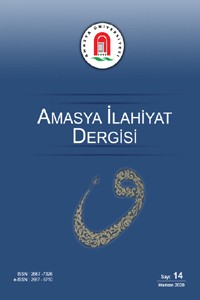A Contribution to the History of Rifâiyya Order in Anatolia: Is “Ahmed-i Kebîr er-Rifâî” “Ahmed-i Kûçek”?
Abstract
Keywords
References
- Eflâkî, Ahmed. Menâkıbü’l-‘ârifîn. 2 Cilt. yay. haz. Tahsin Yazıcı. Ankara: Türk Tarih Kurumu, 1961.
- Eflâkî, Ahmed. Ariflerin Menkıbeleri. çev. Tahsin Yazıcı. İstanbul: Kabalcı Yayınevi, 2006.
- Bayram, Sadi. Merzifon-Amasya Kültür Tarihinde ‘Îdî-zâdeler-Hacıbayramoğulları. Ankara: y.y., 2018.
- Bayram, Sadi. “Lâdik ve Seyyid Ahmed-i Kebîr er-Rufâî Hazretleri”. Türk Dünyası Araştırmaları Dergisi 74 (1991), 139-156.
- Elvân Çelebi. Menâkıbu’l-kudsiyye fi menâsıbi’l-ünsiyye: Baba İlyas-ı Horasanî ve sülalesinin menkabavî tarihi. haz. Ahmed Yaşar Ocak - İsmail E. Erünsal. Ankara: Türk Tarih Kurumu, 2014.
- Evliya Çelebi. Seyâhatnâme: (I-II. Cilt) indeksli tıpkıbasım. 5 Cilt. haz. Seyit Ali Kahraman. Ankara: Türk Tarih Kurumu, 2013.
- Gelibolulu Mustafa Âli. Künhü’l-ahbâr. 5 Cilt. İstanbul: Takvimhane-i Amire, 1277-1285.
- Gölpınarlı, Abdülbakî. Manâkıb-ı Hacı Bektaş-ı Veli: Vilâyet-nâme.İstanbul: İnkılap Kitabevi, 1958.
- Hüseyin Hüsâmeddîn. Amasya Tarihi. Dersaadet: Hikmet Matbaası, 1327-1330.
- Hüseyin Hüsâmeddîn. Amasya Tarihi. 3. Cilt. İstanbul: Necm-i İstikbal Matbaası, 1329-1358.
- Hüseyin Hüsâmeddîn. Amasya Tarihi. 7. Cilt. (Yayın Aşamasında). Amasya Belediyesi.
- İbn Battûta, Ebû Abdullah Muhammed et-Tancî. Mühezzebü rihleti İbn Battûta. haz. Ahmed el-Avâmirî - Muhammed Câdelmevlâ. 2 Cilt. Kahire: Matbaa-i Emîriyye Bulak, 1934-1937.
- İbnü’s-Serrâc, Muhammed b. Ali. Teşvîku’l-ervâh ve’l-kulûb ilâ zikri ‘allâmi’l-guyûb. Amcazâde Hüseyin Paşa, nr. 272. Süleymaniye Kütüphanesi.
- İbnü’s-Serrâc, Muhammed b. Ali. Tüffâhu’l-ervâh ve miftâhü’l-irbâh. Wetzstein II, 396. Berlin Staatsbibliothek.
- İbnü’s-Serrâc, Muhammed b. Ali. Tüffâhu’l-ervâh ve miftâhu’l-irbâh: Ruhların Meyvesi ve Kazancın Anahtarı. çev. Nejdet Gürkan vd.. İstanbul: Kitap Yayınevi, 2015.
- Kılıç, Rüya. Osmanlıda Seyyidler ve Şerifler. İstanbul: Kitap Yayınevi, 2005.
- Kılıç, Mahmut Erol. Anadolu Tasavvuf Tarihine Notlar 1 - Osmanlı Dönemi-Cumhuriyet Dönemi. İstanbul: Sufi Kitap, 2014.
- Mahzûmi, Abdullah Muhammed Sirâceddîn b. Abdullah er-Rifâî. Sıhahu’l-ahbâr fî nesebi’s-sâdeti’l-Fâtımiyyeti’l-ahyâr. Mısır: y.y., 1304.
- Medenî, Es‘ad. “Risâletü’l-Müselsel”. Mecmu‘. 1-45. Kahire: el-Matbaatü’l-Âmireti’ş-Şerefiyye, 1309.
- Ocak, Ahmet Yaşar. Babaîler İsyanı: Alevîliğin Tarihsel Altyapısı Yahut Anadolu’da İslâm-Türk Hetedoroksisinin Teşekkülü. İstanbul: Dergâh, 2016.
- Öztürk, Eyüp. Velilik ile Delilik Arasında: İbnü’s-Serrâc’ın Gözünden Muvelleh Dervişler. İstanbul: Kitap Yayınevi, 2013.
- Sayyâdî, Ebu’l-Hüdâ. Tenvîru’l-ebsâr fî tabakāti’s-sâdeti’r-Rifâ‘iyyeti’l-ahyâr. Matbaa-i Muhammed Efendi Mustafa, Mısır: y.y., 1306.
- Yazıcı, Tahsin. “Ârif Çelebi”. Türkiye Diyanet Vakfı İslam Ansiklopedisi. 3/ 363-363. İstanbul: TDV Yayınları, 1991.
Abstract
İsimleri XIV. asırdan günümüze ulaşan iki Rifâî şeyhinin, aynı ya da ayrı şahsiyetler olup olmadıkları araştırmacılar arasında tartışma konusu olmuştur. Bu isimlerden biri Rifâîliğin Anadolu’daki en önemli temsilcisi kabul edilen Ahmed-i Kûçek; diğeri ise Lâdik’teki türbesi bugün de ziyarete açık olan Sâhibu’l-Hâl Seyyid Ahmed-i Kebîr’dir. Haklarında nakledilen rivayetler, aynı ismi taşıyıp farklı lakaplarla anılan bu zatlar için zaman ve mekan birliğinin söz konusu olduğunu ortaya koymaktadır. Ancak aynı ya da ayrı şahsiyetler olup olmadıkları hakkında kesin bir hükme varabilmek için soy bağlarını ortaya koyan künye bilgilerine ihtiyaç vardır. Bu çalışmada, daha önce üzerlerinde çalışılmamış kaynaklardan istifadeyle, söz konusu iki isme ait künyeler tespit edilerek, farklı lakaplarla tek bir isme işaret edildiği ortaya konulmuştur. Buna göre, Lâdik’te medfun Ahmed-i Kebîr, nâm-ı diğer Ahmed-i Kûçek’tir. Makalede, daha yaygın bir şöhrete sahip Ahmed-i Kûçek ismi tercih edilerek, biyografisi yeniden teşekkül ettirilmiş, böylelikle Ahmed-i Kûçek’in şahsiyetinde Rifâîliğin bu topraklardaki seyri hakkında yeni malumatlar sunulmuştur.
Keywords
References
- Eflâkî, Ahmed. Menâkıbü’l-‘ârifîn. 2 Cilt. yay. haz. Tahsin Yazıcı. Ankara: Türk Tarih Kurumu, 1961.
- Eflâkî, Ahmed. Ariflerin Menkıbeleri. çev. Tahsin Yazıcı. İstanbul: Kabalcı Yayınevi, 2006.
- Bayram, Sadi. Merzifon-Amasya Kültür Tarihinde ‘Îdî-zâdeler-Hacıbayramoğulları. Ankara: y.y., 2018.
- Bayram, Sadi. “Lâdik ve Seyyid Ahmed-i Kebîr er-Rufâî Hazretleri”. Türk Dünyası Araştırmaları Dergisi 74 (1991), 139-156.
- Elvân Çelebi. Menâkıbu’l-kudsiyye fi menâsıbi’l-ünsiyye: Baba İlyas-ı Horasanî ve sülalesinin menkabavî tarihi. haz. Ahmed Yaşar Ocak - İsmail E. Erünsal. Ankara: Türk Tarih Kurumu, 2014.
- Evliya Çelebi. Seyâhatnâme: (I-II. Cilt) indeksli tıpkıbasım. 5 Cilt. haz. Seyit Ali Kahraman. Ankara: Türk Tarih Kurumu, 2013.
- Gelibolulu Mustafa Âli. Künhü’l-ahbâr. 5 Cilt. İstanbul: Takvimhane-i Amire, 1277-1285.
- Gölpınarlı, Abdülbakî. Manâkıb-ı Hacı Bektaş-ı Veli: Vilâyet-nâme.İstanbul: İnkılap Kitabevi, 1958.
- Hüseyin Hüsâmeddîn. Amasya Tarihi. Dersaadet: Hikmet Matbaası, 1327-1330.
- Hüseyin Hüsâmeddîn. Amasya Tarihi. 3. Cilt. İstanbul: Necm-i İstikbal Matbaası, 1329-1358.
- Hüseyin Hüsâmeddîn. Amasya Tarihi. 7. Cilt. (Yayın Aşamasında). Amasya Belediyesi.
- İbn Battûta, Ebû Abdullah Muhammed et-Tancî. Mühezzebü rihleti İbn Battûta. haz. Ahmed el-Avâmirî - Muhammed Câdelmevlâ. 2 Cilt. Kahire: Matbaa-i Emîriyye Bulak, 1934-1937.
- İbnü’s-Serrâc, Muhammed b. Ali. Teşvîku’l-ervâh ve’l-kulûb ilâ zikri ‘allâmi’l-guyûb. Amcazâde Hüseyin Paşa, nr. 272. Süleymaniye Kütüphanesi.
- İbnü’s-Serrâc, Muhammed b. Ali. Tüffâhu’l-ervâh ve miftâhü’l-irbâh. Wetzstein II, 396. Berlin Staatsbibliothek.
- İbnü’s-Serrâc, Muhammed b. Ali. Tüffâhu’l-ervâh ve miftâhu’l-irbâh: Ruhların Meyvesi ve Kazancın Anahtarı. çev. Nejdet Gürkan vd.. İstanbul: Kitap Yayınevi, 2015.
- Kılıç, Rüya. Osmanlıda Seyyidler ve Şerifler. İstanbul: Kitap Yayınevi, 2005.
- Kılıç, Mahmut Erol. Anadolu Tasavvuf Tarihine Notlar 1 - Osmanlı Dönemi-Cumhuriyet Dönemi. İstanbul: Sufi Kitap, 2014.
- Mahzûmi, Abdullah Muhammed Sirâceddîn b. Abdullah er-Rifâî. Sıhahu’l-ahbâr fî nesebi’s-sâdeti’l-Fâtımiyyeti’l-ahyâr. Mısır: y.y., 1304.
- Medenî, Es‘ad. “Risâletü’l-Müselsel”. Mecmu‘. 1-45. Kahire: el-Matbaatü’l-Âmireti’ş-Şerefiyye, 1309.
- Ocak, Ahmet Yaşar. Babaîler İsyanı: Alevîliğin Tarihsel Altyapısı Yahut Anadolu’da İslâm-Türk Hetedoroksisinin Teşekkülü. İstanbul: Dergâh, 2016.
- Öztürk, Eyüp. Velilik ile Delilik Arasında: İbnü’s-Serrâc’ın Gözünden Muvelleh Dervişler. İstanbul: Kitap Yayınevi, 2013.
- Sayyâdî, Ebu’l-Hüdâ. Tenvîru’l-ebsâr fî tabakāti’s-sâdeti’r-Rifâ‘iyyeti’l-ahyâr. Matbaa-i Muhammed Efendi Mustafa, Mısır: y.y., 1306.
- Yazıcı, Tahsin. “Ârif Çelebi”. Türkiye Diyanet Vakfı İslam Ansiklopedisi. 3/ 363-363. İstanbul: TDV Yayınları, 1991.
Details
| Primary Language | Turkish |
|---|---|
| Subjects | Religious Studies |
| Journal Section | Research Articles |
| Authors | |
| Publication Date | June 30, 2020 |
| Published in Issue | Year 2020 Issue: 14 |

